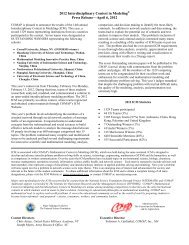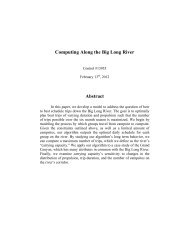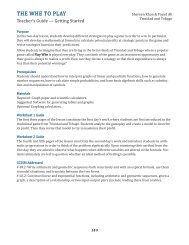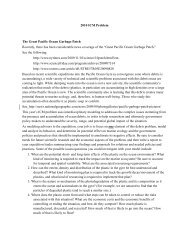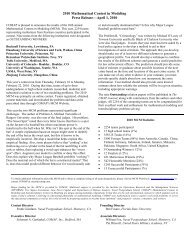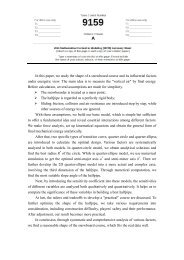Centroids, Clusters and Crime: Anchoring the Geographic Profiles of ...
Centroids, Clusters and Crime: Anchoring the Geographic Profiles of ...
Centroids, Clusters and Crime: Anchoring the Geographic Profiles of ...
Create successful ePaper yourself
Turn your PDF publications into a flip-book with our unique Google optimized e-Paper software.
Team # 7507 Page 29<br />
results would converge). Indeed, <strong>the</strong> only difference is that <strong>the</strong> cluster method, insisting on at<br />
least two separate clusters, identifies <strong>the</strong> point directly below <strong>the</strong> centroid as a cluster <strong>of</strong> one<br />
(an outlier), <strong>and</strong> <strong>the</strong>refore excludes it from <strong>the</strong> computation <strong>of</strong> <strong>the</strong> larger cluster’s centroid (a<br />
slight Gaussian contribution from this point’s “own” cluster can be seen in <strong>the</strong> surface plot).<br />
This has <strong>the</strong> effect <strong>of</strong> slightly reducing <strong>the</strong> variance <strong>and</strong> <strong>the</strong>refore narrowing <strong>the</strong> fit function;<br />
consequently, <strong>the</strong> st<strong>and</strong>ard effectiveness multiplier rises slightly to 15.82.<br />
Testing with Offender B (see Figure 13), by contrast, shows <strong>the</strong> cluster method operating at<br />
<strong>the</strong> o<strong>the</strong>r edge <strong>of</strong> its range, as <strong>the</strong> silhouette optimization routine decides this data is best represented<br />
by four distinct clusters with four separate anchor points. After unblinding <strong>the</strong> details <strong>of</strong><br />
this case, we discover that <strong>the</strong> researcher documenting <strong>the</strong> case also found it notable for <strong>the</strong> fact<br />
that <strong>the</strong> <strong>of</strong>fender seemed to choose his targets alternately between three city blocks, <strong>the</strong>n briefly<br />
exp<strong>and</strong>ed his range geographically to an additional neighborhood fur<strong>the</strong>r away before returning<br />
to <strong>of</strong>fend again in one <strong>of</strong> his earlier active areas. The researcher hypo<strong>the</strong>sizes this may have<br />
been a tactic to avoid known locations <strong>of</strong> parole <strong>of</strong>ficers, as <strong>the</strong> <strong>of</strong>fender was a parolee during<br />
<strong>the</strong> majority <strong>of</strong> his crimes;[9] whatever <strong>the</strong> reason, it is a success (if a statistically insignificant<br />
one) for our model that we discerned this pattern from <strong>the</strong> geographic dispersion alone. This<br />
data-set also provides a good example <strong>of</strong> a case where multiple anchor point analysis seems<br />
valid even though most do not represent homes or workplaces: <strong>the</strong> model is simply responding<br />
to <strong>the</strong> statistical evidence that criminal seems most comfortable committing crimes in one <strong>of</strong> 4<br />
distinct locations.<br />
On first glance, however, it might appear that <strong>the</strong> centroid method still outperforms <strong>the</strong><br />
cluster algorithm for this data-set; after all, <strong>the</strong> actual crime point no longer appears in <strong>the</strong><br />
b<strong>and</strong> <strong>of</strong> maximum likelihood. This is true <strong>and</strong> intentional, as <strong>the</strong> model chooses to weight<br />
<strong>the</strong> largest cluster most strongly <strong>and</strong> <strong>the</strong> “freshest” cluster behind it. Never<strong>the</strong>less, while not<br />
accurately predicting that <strong>the</strong> <strong>of</strong>fender would choose to return to one <strong>of</strong> his earliest activity<br />
zones, it still outperforms <strong>the</strong> centroid method with a κ s value <strong>of</strong> 22.95. This is because <strong>the</strong><br />
craters generated by <strong>the</strong> cluster method are sharper <strong>and</strong> taller for this data set, so <strong>the</strong>re are<br />
fewer resources “wasted” at high-likelihood areas where no crime is committed. We argue that<br />
this is <strong>the</strong> correct weighting, a model which makes a bolder, narrower prediction which is still<br />
successful is more valuable than one which covers <strong>the</strong> right point by simply splashing guesses<br />
across a large swath <strong>of</strong> area.<br />
Unsurprisingly, <strong>the</strong> cluster model fares no better than <strong>the</strong> centroid method when confronted<br />
with Offender A (see Figure 14). Indeed, since <strong>the</strong> outlier points are excluded from <strong>the</strong> centroid<br />
calculation for <strong>the</strong> larger cluster, <strong>the</strong> model bets even more aggressively on this macro-cluster,<br />
<strong>and</strong> with a resulting measurement <strong>of</strong> κ s =0.001, we can see that following this procedure<br />
would virtually eliminate <strong>the</strong> ability <strong>of</strong> <strong>the</strong> police to anticipate <strong>the</strong> next crime.







